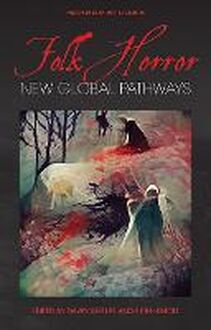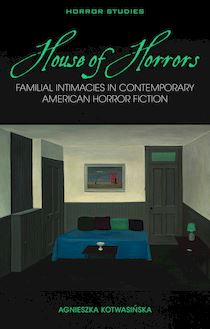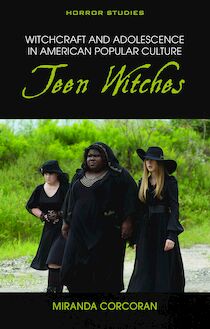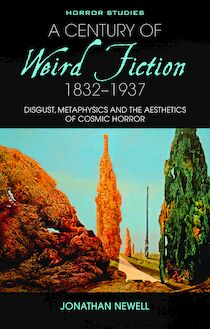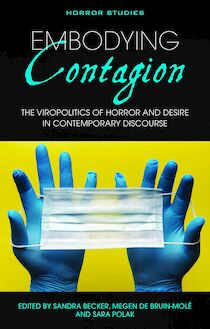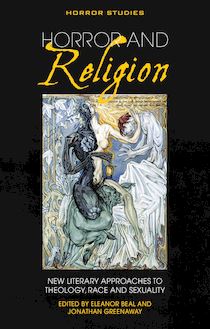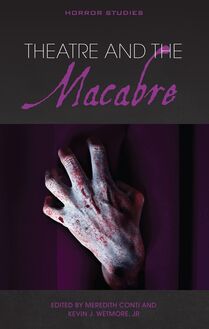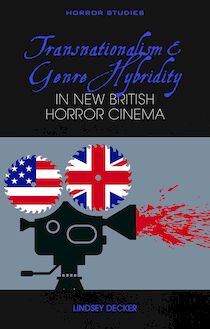Masks in Horror Cinema , livre ebook
147
pages
English
Ebooks
2019
Vous pourrez modifier la taille du texte de cet ouvrage
Obtenez un accès à la bibliothèque pour le consulter en ligne En savoir plus
Découvre YouScribe en t'inscrivant gratuitement
Découvre YouScribe en t'inscrivant gratuitement
147
pages
English
Ebooks
2019
Vous pourrez modifier la taille du texte de cet ouvrage
Obtenez un accès à la bibliothèque pour le consulter en ligne En savoir plus
Publié par
Date de parution
15 octobre 2019
Nombre de lectures
0
EAN13
9781786834980
Langue
English
Why has the mask been such an enduring generic motif in horror cinema? This book explores its transformative potential historically across myriad cultures, particularly in relation to its ritual and mythmaking capacities, and its intersection with power, ideology and identity. All of these factors have a direct impact on mask-centric horror cinema: meanings, values and rituals associated with masks evolve and are updated in horror cinema to reflect new contexts, rendering the mask a persistent, meaningful and dynamic aspect of the genre’s iconography. This study debates horror cinema’s durability as a site for the potency of the mask’s broader symbolic power to be constantly re-explored, re-imagined and re-invented as an object of cross-cultural and ritual significance that existed long before the moving image culture of cinema.
Acknowledgements
Introduction - Why Masks? Ritual, Power and Transformation
Chapter One: Situating Masks and Horror Cinema
Part One: Masks, Horror and Cinema: Towards Codification
Chapter Two: Masks and Horror in Literary and Performance Traditions and Early Cinema
Chapter Three: Masks in Horror Film Before 1970
Part Two: Horror Film Masks from 1970
Chapter Four: Skin Masks: Ritual, Power and Transformation
Chapter Five: Blank Masks: Ritual, Power and Transformation
Chapter Six: Animal Masks: Ritual, Power and Transformation
Chapter Seven: Repurposed Masks: Ritual, Power and Transformation
Part Three: Masks as Transformational Technologies – Moving Forward By Looking Back
Chapter Eight: Technological Masks: Ritual, Power and Transformation
Conclusion
Bibliography
Publié par
Date de parution
15 octobre 2019
Nombre de lectures
0
EAN13
9781786834980
Langue
English
Masks
IN HORROR CINEMA
HORROR STUDIES
Series Editor
Xavier Aldana Reyes, Manchester Metropolitan University
Editorial Board
Stacey Abbott, Roehampton University
Linnie Blake, Manchester Metropolitan University
Harry M. Benshoff, University of North Texas
Fred Botting, Kingston University
Steven Bruhm, Western University
Steffen Hantke, Sogang University
Joan Hawkins, Indiana University
Agnieszka Soltysik Monnet, University of Lausanne
Bernice M. Murphy, Trinity College Dublin
Johnny Walker, Northumbria University
Preface
Horror Studies is the first book series exclusively dedicated to the study of the genre in its various manifestations – from fiction to cinema and television, magazines to comics, and extending to other forms of narrative texts such as video games and music. Horror Studies aims to raise the profile of Horror and to further its academic institutionalisation by providing a publishing home for cutting-edge research. As an exciting new venture within the established Cultural Studies and Literary Criticism programme, Horror Studies will expand the field in innovative and student-friendly ways.
Masks
IN HORROR CINEMA
EYES WITHOUT FACES
ALEXANDRA HELLER-NICHOLAS
© Alexandra Heller-Nicholas, 2019
All rights reserved. No part of this book may be reproduced in any material form (including photocopying or storing it in any medium by electronic means and whether or not transiently or incidentally to some other use of this publication) without the written permission of the copyright owner except in accordance with the provisions of the Copyright, Designs and Patents Act. Applications for the copyright owner’s written permission to reproduce any part of this publication should be addressed to the University of Wales Press, University Registry, King Edward VII Avenue, Cardiff, CF10 3NS.
www.uwp.co.uk
British Library Cataloguing-in-Publication Data
A catalogue record for this book is available from the British Library.
ISBN 978-1-78683-496-6
eISBN 978-1-78683-498-0
The right of Alexandra Heller-Nicholas to be identified as author of this work has been asserted in accordance with sections 77 and 79 of the Copyright, Designs and Patents Act 1988.
The publisher has no responsibility for the persistence or accuracy of URLs for any external or third-party internet websites referred to in this book, and does not guarantee that any content on such websites is, or will remain, accurate or appropriate.
Cover image: Eyes without a Face, dir. Georges Franju (Lux Film, 1960), poster.
PictureLux / The Hollywood Archive / Alamy Stock Photo.
For Casper and Christian
Contents
Acknowledgements
Introduction
1. Situating Masks and Horror Cinema
Part One: Masks, Horror and Cinema – Towards Codification
2. Masks and Horror in Literary and Performance Traditions and Early Cinema
3. Masks in Horror Film before 1970
Part Two: Horror Film Masks from 1970 – Case Studies
4. Skin Masks: Ritual, Power and Transformation
5. Blank Masks: Ritual, Power and Transformation
6. Animal Masks: Ritual, Power and Transformation
7. Repurposed Masks: Ritual, Power and Transformation
Part Three: Masks as Transformational Technologies – Moving Forward by Looking Back
8. Technological Masks: Ritual, Power and Transformation
Conclusion
Endnotes
Bibliography
Acknowledgements
W ITH A PROJECT of this scale there are of course many people to thank. First, I must acknowledge Angela Ndalianis without whose practical and emotional support this would never have got off the ground, let alone ever be finished. Many thanks to the Horror Studies series editor Xavier Aldana Reyes and Sarah Lewis at University of Wales Press for the privilege of inviting me to join the series, and for their unceasing warmth, support and encouragement. I would also like to thank Stephen Morgan for his assistance in sourcing the Abel Gance documentation vital to chapter 2, as well as Julien Allen, Franck Boulègue and Samuel Bréan for their translation assistance of this material, and to Kevin Heffernan and Mark Jancovich for their invaluable feedback on the original thesis version of this book. Josh Nelson went well above and beyond the call of duty on pretty much all fronts (including his impressive copy-editing prowess), and I would also like to thank the following for their support: Anton Bitel, Sally Christie, Anna Dzenis, John Edmond, Giles Edwards, Mark Freeman, Lee Gambin, Wendy Haslem, Jade Henshaw, Ian Gouldstone, Anne Marsh, Craig Martin, Jan Napiorkowski, Tim O’Farrell, David Surman and Emma Westwood. As always, thanks to my family, Richard, Lorraine, Max, Fiona and Robert, and with particular love and gratitude to Casper and Christian.
Introduction
L ITTLE IS KNOWN of mononymous Belarusian film director Makinov, director of Come Out and Play , the 2012 Mexican remake of the Spanish horror classic Who Can Kill a Child? ( ¿Quién puede matar a un niño? , Narciso Ibáñez Serrador, 1976). While masks have long been an iconographic staple of horror cinema, Makinov took this generic fascination to its logical extreme: not only did he promote the film wearing a crude red sack mask with eyeholes cut out, but the cast and crew of Come Out and Play allegedly never saw his face during the production itself. 1 In a video introduction to a 2012 Toronto International Film Fest screening of Come Out and Play , Makinov said ‘I wear my mask because through anonymity I can be all I want. As a beloved writer says, I believe in my mask, the man I made up is me. I believe in my dance and my destiny.’ 2 Through this reference to Sam Shepard’s The Tooth of Crime (1972), this horror film-maker made clear his belief that there is a meaningful connection between power, creativity and identity. Whether a publicity stunt or a material manifestation of his aesthetic philosophy, this is a memorable instance of the potency of horror film masks being deployed beyond the fictional constraints of cinema to make a statement.
As a horror film-maker, Makinov’s mask consciously evokes a long history. Masks are closely linked to the horror legacies of icons like Lon Chaney Sr. and Vincent Price and in slasher franchises like Friday the 13th (1980–2009) and Halloween (1978–2018). When used diegetically, horror film masks imply associations with broader notions of identity and there are complexities embedded in how they are both deployed and are understood over time: their symbolic potency as objects linked to ritual, power and transformation has evolved over history. The conceptual force of horror film masks stems from both its generic ubiquity and simultaneous status as a cross-cultural associated with a complex range of historically defined meanings and values. These meanings and values are constantly evolving in horror to reflect new cultural and ideological contexts, rendering masks a persistent and important element of the genre’s iconography. There is a crucial tension at play across the history of horror film masks between variation and consistency: while the mask is itself an enduring element of the genre, the meanings and values attached to it are demonstrably dynamic and adaptable.
From the outset, it must be stated that horror masks are not specific to only feature-length horror films, and horror narratives and media experiences across television and videogames are themselves worthy of future discussion and exploration, spanning as they do from a long literary history where masks and horror intersect (that will be discussed elsewhere in this book). The focus here, however, is specifically on horror feature films as they have a much longer history as a screen phenomenon that privileges masks. It thus can inform future examinations of other media, be it in terms of how it overlaps or – just as significantly – how it deviates. Horror film masks are a continuation of a multifaceted historical trajectory, their transformative potential continuing ritualistic and myth-making processes linked both to power, ideology and identity (as seen across myriad cultures with a recorded history of privileging this object) and also to genre itself. Horror film masks provoke associations with disguise and anonymity with a predominantly narrative purpose: to obscure – then possibly expose – the identity of a killer. Yet this reduces the utility of horror film masks to purely one of revelation and occlusion. While not untrue, often in horror movies we know the identity of the mask wearer: there is, for instance, no mystery about the Halloween franchise’s slasher killer Michael Myers or that of the Friday the 13th films, Jason Voorhees. To conceive horror film masks solely as anonymity-creating devices undermines the power of the objects themselves. Even in their earliest, supposedly ‘primitive’ usages, masks were often bestowed with great power in terms of spiritual belief across a range of religious practices. This power is linked closely to masks as transformative devices.
Focusing on the intersection of ritual (be it secular or religious), power and transformation, we can see that horror cinema is a durable forum for the enduring potency of the mask’s broader symbolic power to be constantly re-explored, re-imagined and re-invented, continuing key aspects of its cross-cultural and ritual significance that existed long before moving image culture. While there have been numerous critical examinations of horror film masks in specific movies, franchises, national and subgeneric contexts, there remains a broad absence of any substantial critical research dedicated to horror film masks and how they intersect with cultural histories of masks more broadly. We can employ this past research to assist building the foundations of a focused, critical analysis of horror film masks, synthesising and expanding upon these scattered treatments to map a cultural history of horror film masks, focusing specifically on ritual, power and transformation.
Chapter 1 expands on
